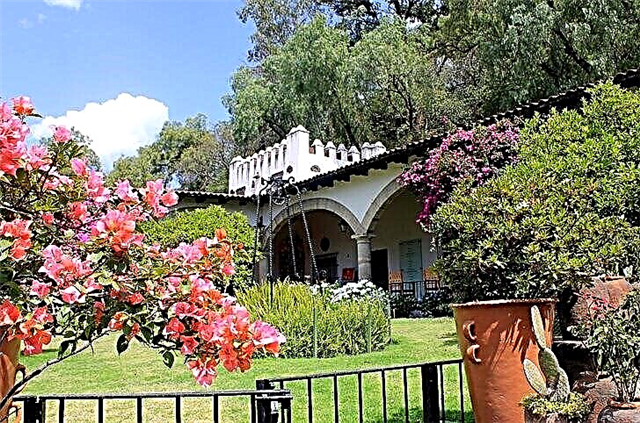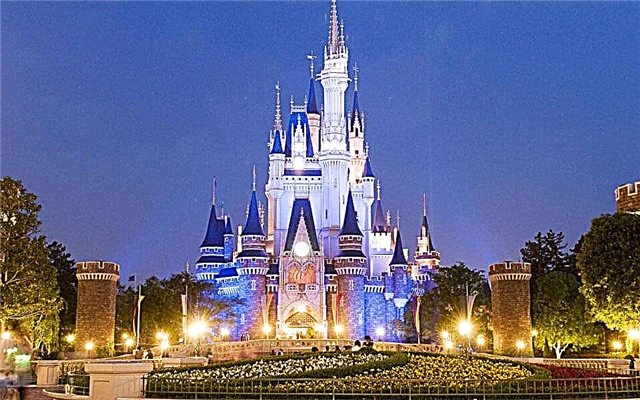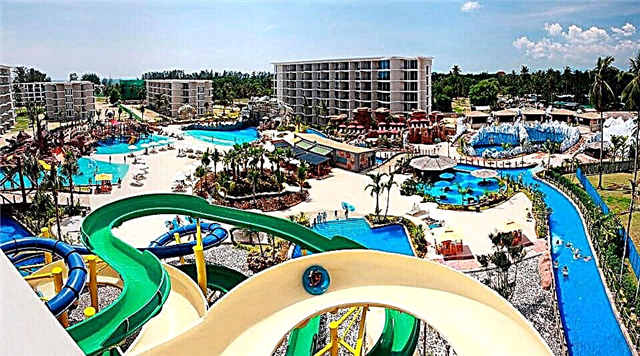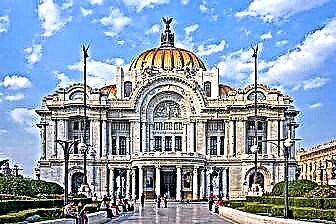Mexico City is a huge "human anthill" located in a green valley among mountains and volcanoes, in the ancient land of the Aztecs. This city seems to have absorbed everything: the centuries-old history of Indian peoples, the adventurism and greed of the first Spanish conquistadors, archaic Catholic morality and quite modern tolerance.
Tourists come to Mexico City to listen to the soulful songs of the Mariachi musicians, taste the scorching dishes of Mexican cuisine and plunge headlong into the mysterious and attractive atmosphere of Spanish-American culture. The city will surely delight guests with its magnificent palaces and interesting museums, where the treasures of civilizations almost erased from the face of the earth are hidden.

The best hotels and hotels at affordable prices.
from 500 rubles / day
What to see and where to go in Mexico City?
The most interesting and beautiful places for walking. Photos and a short description.
Palace of Fine Arts
An imposing opera house built of Carrara marble. The grandiose palace has adorned the center of the Mexican capital since the 1930s. The building was erected by the Italian architect A. Boari in the styles of neoclassicism, art-duvo and boz-aryu. Inside, the walls are decorated with drawings by Mexican artists D. Rivera, JC Orozco, A. Siqueiros, F. Mariscal and other artists. Today the Palace of Fine Arts is the most popular attraction in the capital.

Chapultepec Palace
The palace is located on the hill of the same name. Previously, it was the official residence of the rulers and governors of Mexico. The building began to be built at the end of the 18th century under Viceroy Bernardo de Galvez, but due to lack of funds it had to be put up for auction. In 1833, a military academy was housed in the palace; in 1864, Emperor Maximilian Habsburg settled here. Today, the building houses the National History Museum.

Constitution Square
Another name for the square is Zocalo. It is the largest in Latin America and one of the largest in the world (over 46 thousand square meters). In the middle there is a powerful flagpole, on which the national banner flutters. There are two famous landmarks on the square - the National Palace and the city's cathedral. For the construction of the Zocalo, stones were used, brought from the ruins of the Aztec city of Tenochtitlan.

Paseo de la Reforma
The main alley of the Mexican capital, which is a wide avenue. It was founded in the 1860s. under Emperor Maximilian. The project was based on the proportions of the streets of European capitals. The length of the avenue is about 12 km. It stretches from Chapultepec Park to Madero Street. The main local attraction is the "Angel of Independence" column, erected in honor of the country's victory in the struggle for freedom.

Mexico City Cathedral
The main Catholic church in Mexico, one of the oldest and most significant in Latin America. The first church on the site of a modern building was founded in the 16th century by Hernan Cortez. Today it is located in the northeastern part of the cathedral. For the construction of the grandiose building, the stones of the destroyed temple of the god of war Huitzilopochtli were used. The building is designed in the style of colonial architecture.

Basilica of the Virgin Mary of Guadalupe
Virgin Mary of Guadalupe is the patron saint of the country, she is even called "the mother of all Mexicans." The basilica contains her image (the image on the cape), allegedly acquired by the Indian Juan Diego, who even had the honor to see the Virgin with his own eyes. The basilica was erected on the spot where this miraculous event took place. The church is an important pilgrimage center where thousands of Mexicans flock.

National Palace
The current residence of the President of the country, which is located on Zocalo Square. The building was built in the Baroque style, or rather, in its Mexican version. The grandiose structure has three floors and a length of more than 200 meters. The palace was designed by order of Hernán Cortez. The interior is decorated with magnificent frescoes by the famous artist Diego Rivera, dedicated to important milestones in the history of Mexico.

Post palace
The complex was built by order of the dictator Diaz at the beginning of the 20th century. The architectural style of the palace can be defined as eclecticism, as features of the Venetian and French manners are mixed in its appearance. The interiors of the building are distinguished by splendor and luxury - the space is richly decorated with marble, stucco, gilding, and metal decorations. The building houses the main post office of Mexico.

National Anthropological Museum
The museum is located within the Chapultepec Park. His collections are dedicated to the history of Mexico in the pre-Columbian period. The spacious exhibition halls house artifacts found on the territory of the country and are material evidence of the high level of prosperity of Indian civilizations. For example, the museum contains a stone figure of the rain god and the "Stone of the Sun" - the famous Aztec calendar.

Templo Major
Tepmlo Major or "great temple" in Spanish is the ruins of the pyramid of the gods Tlaloc and Huitzilopochtli, left after the destruction of the Aztec city of Tenochtitalan. Once the building was 60 meters long and served as an important religious center. With the arrival of Hernan Cortes, the temples were destroyed. Only in the XX century, during construction work, a part of the base of the pyramid was discovered.

Frida Kahlo House Museum
Frida Kahlo is an artist, communist and rebel. She became a real symbol of the country and won universal popular love. A museum dedicated to the life and work of this extraordinary personality was opened in 1955 in a house that belonged to the Kahlo family at the beginning of the 20th century. Here she lived with her husband Diego Rivera. In the 1930s. the couple hid Leon Trotsky with his wife for some time.

Diego Rivera Fresco Museum
The collection of the museum consists of only one exhibit - a piece of the Prado Hotel wall painted by the artist D. Rivera. After the 1985 earthquake, the hotel had to be demolished, but they decided to keep the unique fresco for posterity. The painting is called "A Sunday Dream in Alameda Park." It has quite impressive dimensions - 15 meters long, 4 meters wide, as well as a heavy weight of 7 tons.

House-Museum of Leon Trotsky
The museum is located in the house where Leon Trotsky lived the last months of his life until he was killed by an NKVD agent. Prior to that, he and his wife lived for two years in the villa of the artist Frida Kahlo. The exposition opened in 1990. Today it includes a library with the collected works of Lev Davidovich, modern Trotskyist literature, as well as documents and personal belongings of the revolutionary.

Museum of Folk Art
The first visitors saw the collection in 2006. It was created with the aim of popularizing Mexican traditional culture, which is a bizarre mix of ancient Native American beliefs and Catholicism. Here are collected sculptures, ceramics and wood products, paintings, jewelry and other works of folk art. The museum has courses on training in various crafts and an educational center.

National Museum of Art
The exposition consists of works by Mexican artists who worked from the 16th to the 20th century. The museum houses more than 3 thousand exhibits, each of which belongs to a specific time. There are three main parts in the collection: paintings painted during the colonial era, after the country's independence and after the Mexican Revolution. The building itself is an example of Mexican architecture of the early 20th century.

Museum of Memory and Tolerance
The museum was created with the aim of drawing public attention to crimes against humanity, as well as the consequences of intolerance. It touches upon the issues of the genocide of nations, discrimination against individual peoples and groups of society, and raises urgent problems in the field of human rights. The museum has a room for children, where they are taught about tolerance in a fun way.

Soumaya Museum
The collection is housed in a modern 2011 anvil-shaped building. The museum was founded with funds from Mexican billionaire K. Slim to house his personal art collection. The exposition consists of paintings by local and European masters. Here you can see paintings by C. Monet, P. Renoir, C. Pissarro, E. Degas, as well as sculptures by Rodin.

Dolores Olmedo Museum
Dolores Olmedo became famous for having an affair with the artist Diego Rivera. She was also a very wealthy woman and during her life managed to collect a rich collection of art objects, consisting of several dozen paintings. In 1994, a museum named after her was opened, where the collection was put on display to the public. Among the exhibits are not only paintings, but also Dolores' decorations and sculptures.

Latin american tower
Mexican 44-storey skyscraper, built in the 1950s by A. Alvarez and M. de la Colina. The architects even received an award for being able to deliver such a tall building in an earthquake-prone area. Most of the building houses the offices of commercial organizations, the space from the 37th to the 44th floor is occupied by a museum, and there are observation platforms on the 42nd and 45th floors.

Azteca stadium
The football arena, which is one of the largest in the world. Its stands can accommodate up to 105,000 spectators, although often many more people are seated on the seats. The decisive matches of the FIFA World Cup took place here twice, and once - the Summer Olympic Games. The stadium was built in 1966, after 20 years the first reconstruction was carried out.

Mercado de Artesania
A great place to shop for a variety of souvenirs, many of which cannot be found elsewhere. It sells traditional ceramics, national clothes, interesting products of Mexican craftsmen and many other things. A great bonus for Spanish speaking tourists is the extra discount from sellers. For those who speak only English, prices will obviously be higher.

Sochimilco
The outskirts of the Mexican capital, known for the fact that on its territory are located the Aztec canals - chinampas. Once upon a time, flowers were massively grown here, today guests and residents of Mexico City ride on trachineer gondolas. The total length of the canals is over 170 km, tourist routes are laid for 14 km. In 1987, Xochimilco was included in the UNESCO World Heritage List.

Island of the Dolls
The creepy island is located about 18 km from Mexico City. It looks like the scenery for some mystical thriller: broken old dolls and parts of their bodies hang everywhere. A strange collection was collected by the hermit D.S.Barrera, who accidentally witnessed the tragic death of a little girl. Apparently, since then, the man was moved by his mind and addicted to such a strange hobby.

Park "Alameda Central"
An urban landscape park with French-style fountains, cobbled alleys and decorative statues, located on the site of the former square of El Camadero, where heretics were burned until the 18th century. Poplars grow here in large numbers, which is why it got the name "Alameda" (this is the name of the tree in Spanish). Today the park is one of the favorite places for recreation and walking.

Chapultepec Park
A huge park of 800 hectares around the hill of the same name in the center of Mexico City. During the time of the Aztec Empire, the ruler's country palace was located here, connected to Tenochtitlan by a bridge. On the territory of Chapultepec there is a zoo, a rock with the image of the Aztec emperor Montezuma I, the National Museum of Anthropology and other interesting sights.












